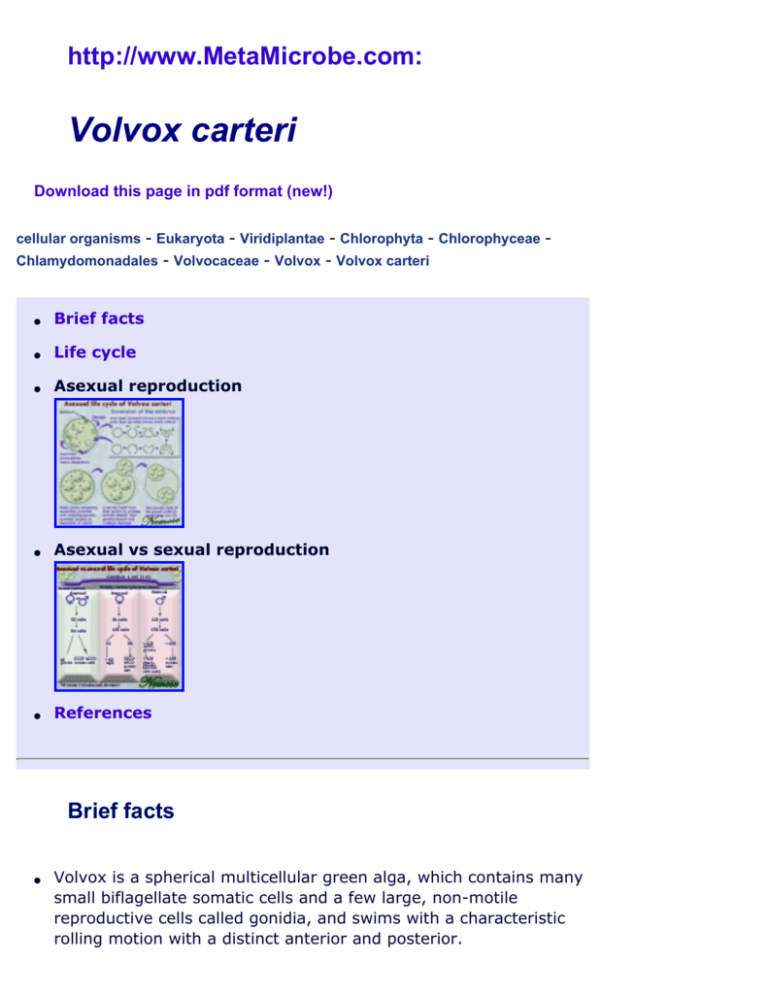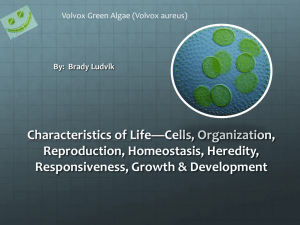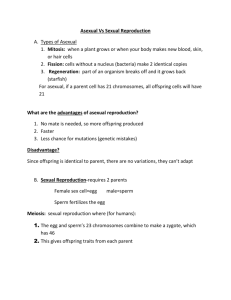
http://www.MetaMicrobe.com:
Volvox carteri
Download this page in pdf format (new!)
- Eukaryota - Viridiplantae - Chlorophyta - Chlorophyceae Chlamydomonadales - Volvocaceae - Volvox - Volvox carteri
cellular organisms
●
Brief facts
●
Life cycle
●
Asexual reproduction
●
Asexual vs sexual reproduction
●
References
Brief facts
●
Volvox is a spherical multicellular green alga, which contains many
small biflagellate somatic cells and a few large, non-motile
reproductive cells called gonidia, and swims with a characteristic
rolling motion with a distinct anterior and posterior.
The name Volvox comes from the Latin volvere, to roll, and -ox,
as in atrox, fierce.
●
A medium in which the organism would thrive and reproduce in
captivity was discovered only in the 1960s. Only after that it
became possible to exploit Volvox as a laboratory model system.
●
In nature Volovox is found in ponds and ditches.
●
Life cycle
Volvox has 2 modes of reproduction: sexual and asexual.
●
sexual
in nature V. carteri reproduces sexually at least once
each year when temporary ponds where the organism
lives start to dry out in the heat of late summer; the
stimulus for switching from the asexual to the sexual
mode of reproduction is known to be a sex-inducing
pheromone, a 32-kDa glycoprotein triggers sexual
development of gonidia at concentrations as low as 10(16) M.
❍
sexual induction
gonidia that have been exposed to the sexinducing pheromone for at least 6–8 h before
the initiation of embryonic cleavages modify
their developmental program and produce
sexual progeny containing immotile eggs or
motile sperm, depending on the genetic sex of
the individual; the sexual cycle is initiated by a
heat shock that causes the somatic cells of the
asexual Volvox spheroid to produce the sexinducing pheromone; the level of pheromone is
then further amplified by the ability of sperm
cells to produce more sex-inducing pheromone
❍
gametogenesis MeSH
the 64–128 cell transition in sexual females, and
the 128–256 cell transition in sexual males; in
sexual males, somatic cells (smaller spheres)
and androgonidia (larger spheres) arise in a 1:1
ratio; androgonidia undergo further cleavages to
form sperm packets, each containing 64 or 128
sperm; when the gametes are mature, sperm
packets are released into the surroundings
❍
zygote MeSH
on contact with females, the sperm packets
break up into individual sperm, which can
fertilize the eggs. The resulting diploid zygotes
have tough cell walls that can resist drying, heat
and cold. When favourable conditions cause the
zygotes to germinate, they undergo meiosis to
produce haploid males and females that
reproduce asexually until the sex-inducing
pheromone induces the sexual cycle again
●
asexual
males and females are indistinguishable in their asexual
form; under standard conditions, the asexual life cycle
takes 48 h and is synchronized by a 16 h light–8h dark
cycle
❍
embryogenesis MeSH
■
cleavage
embryogenesis takes ~8 hours; mature
gonidia undergo a rapid series of
cleavage divisions (11–12 divisions),
some of which are asymmetric: the larger
cells resulting from these unequal
divisions will become the gonidia of the
next generation, whereas the smaller
cells will become part of the somatic cell
population; at the end of cleavage, the
embryo is inside out with respect to the
adult configuration: its gonidia are on the
outside and the flagella of its somatic
cells are pointing towards the interior of
the hollow sphere
■
inversion
the morphogenetic process of inversion
taking place at the end of embryogenesis
returns the embryo to its adult
configuration through a series of cell
movements that resemble the
gastrulation of animal embryos
■
expansion
the juveniles expand by deposition of
extracellular matrix
■
release
juveniles hatch from their parent
spheroid
●
juvenile
organism with immature gonidia
●
adult
organism with mature gonidia
●
senescent MeSH
somatic cells of the parent, lacking reproductive cells
and thus being incapable of further cleavage, undergo
senescence and die
References
Articles
●
●
Hallmann A, Godl K, Wenzl S, Sumper M.The highly efficient sexinducing pheromone system of Volvox. Trends Microbiol. 1998
May;6(5):185-9. PMID: 9614342
PubMed free full text articles: major topic "Volvox"
Websites
●
CELL BIOLOGY: ON VOLVOX
●
Wikipedia: Volvox
Last updated 03/15/09
nemose@live.com
©Nemose 2008-2009 All rights reserved








